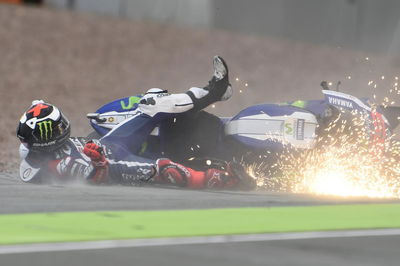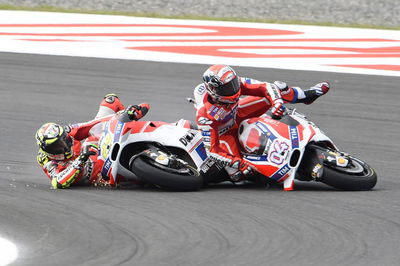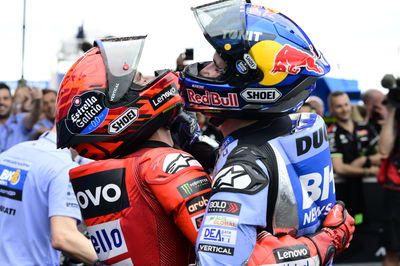Michelin: One fall is one too many

This year's motorcycle grand prix season saw more than 1,000 falls over the three classes, an all-time high.
The 1062 accidents were divided; 288 in MotoGP, 364 in Moto2 and 410 in Moto3.
But while the smaller classes had suffered more accidents in past seasons (since data was recorded in 2006), MotoGP exceeded its previous season record by 73 falls.
 |
| Falls per year (all classes). |
 |
| Falls per year (by class). |
 |
| Falls per year: MotoGP only. |
So what happened?
Facing the brunt of the finger pointing was new tyre supplier Michelin.
In fairness, it would be surprising if fundamentally changing the only part of the motorcycle that touches the track resulted in fewer falls, but 73 did seem excessive.
"One fall is one too many and something we will work on," said Michelin Racing's technical director Nicolas Goubert. "We are working and to make the bikes as easy as possible to ride. That will be a permanent direction to improve. I think all tyre makers in two-wheel racing are working on that."
Goubert was at pains to point out that the crash comparison was far more favourable when only race falls were concerned (81 this year, 70 last year). The race-only comparison didn't convince everyone, but most would agree falls should reduce in 2017 due to further development, plus increased experience and understanding of the tyres.
MotoGP teams had been using Bridgestone rubber from 2009-2015.
"This was the first season for us and also the teams," said Piero Taramasso, manager of Michelin's Two-Wheel Motorsport Group. "We saw teams improving race-by-race, as they understand better how the tyre works.
"So for sure next season the bikes will be more suited to our tyres. The geometry, the setting, the suspension and everything. For sure, the match between the motorbike and tyres will be better."
"It's a very important point," Goubert added, "because although we of course worked to improve the tyres throughout the year, the teams also did a lot of work to find the right set-up and the riders changed slightly their riding styles. So all of that together, that combined effort, gives better results at the end and as Piero said they will continue with that experience."
Weather always plays a significant role in accidents, but in terms of actual wet races there were four this year and last. Michelin did want to emphasise how they had reacted after being thrown in the 'deep end' during their first wet race at Assen (which alone counted for 14 of its 81 race accidents).
"When we arrived in Assen it was a big, big surprise," Goubert admitted. "Conditions were tremendous and the grip level was not at all where we expected it to be and basically we suffered many crashes.
"Having said that, once again we reacted very quickly, within two weeks for the following race at the Sachsenring we brought two new [wet] front tyres with different compounds and profiles and the results were very positive. As they were in Phillip Island and in Sepang."
 |
| Falls per track session. |
It's not hard to guess which is the most dangerous track session of the weekend for any class: The race. But the second most dangerous might be something a surprise for MotoGP.
While qualifying was a clear runner-up for the Moto2 and Moto3 classes, it was FP3 in MotoGP.
MotoGP has a different qualifying structure compared to the smaller categories, with the top ten after Saturday morning practice gaining direct access to the final part of qualifying. Throw in cooler track temperatures and it's easy to see why FP3 has become something of a hazard.
It's not quite that simple though.
While Moto2 and Moto3 qualifying are the same length of time as free practice, MotoGP FP1-3 are 45mins, followed by a 30min FP4 and 15mins each for Qualifying 1 and Qualifying 2. And unlike Moto2 and Moto3, not all riders take part in each MotoGP qualifying session.
If the FP4, Q1 and Q2 accidents were added together to form a single-session it would equate to 67 accidents, more than FP3.












